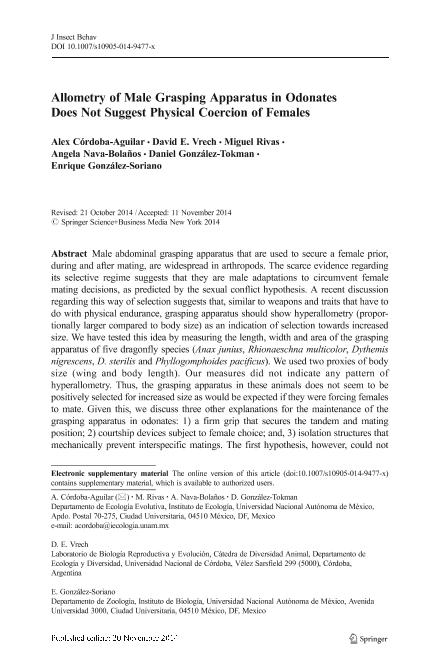Artículo
Allometry of Male Grasping Apparatus in Odonates Does Not Suggest Physical Coercion of Females
Córdoba Aguilar, Alex; Vrech, David Eduardo ; Rivas, Miguel; Nava Bolaños, Angela; González Tokman, Daniel; González Soriano, Enrique
; Rivas, Miguel; Nava Bolaños, Angela; González Tokman, Daniel; González Soriano, Enrique
 ; Rivas, Miguel; Nava Bolaños, Angela; González Tokman, Daniel; González Soriano, Enrique
; Rivas, Miguel; Nava Bolaños, Angela; González Tokman, Daniel; González Soriano, Enrique
Fecha de publicación:
01/2015
Editorial:
Springer/Plenum Publishers
Revista:
Journal of Insect Behavior
ISSN:
0892-7553
e-ISSN:
1572-8889
Idioma:
Inglés
Tipo de recurso:
Artículo publicado
Clasificación temática:
Resumen
Male abdominal grasping apparatus that are used to secure a female prior, during and after mating, are widespread in arthropods. The scarce evidence regarding its selective regime suggests that they are male adaptations to circumvent female mating decisions, as predicted by the sexual conflict hypothesis. A recent discussion regarding this way of selection suggests that, similar to weapons and traits that have to do with physical endurance, grasping apparatus should show hyperallometry (proportionally larger compared to body size) as an indication of selection towards increased size. We have tested this idea by measuring the length, width and area of the grasping apparatus of five dragonfly species (Anax junius, Rhionaeschna multicolor, Dythemis nigrescens, D. sterilis and Phyllogomphoides pacificus). We used two proxies of body size (wing and body length). Our measures did not indicate any pattern of hyperallometry. Thus, the grasping apparatus in these animals does not seem to be positively selected for increased size as would be expected if they were forcing females to mate. Given this, we discuss three other explanations for the maintenance of the grasping apparatus in odonates: 1) a firm grip that secures the tandem and mating position; 2) courtship devices subject to female choice; and, 3) isolation structures that mechanically prevent interspecific matings. The first hypothesis, however, could not explain the highly elaborated and species specific morphology of grasping apparatus in these animals. Support for the second hypothesis comes from the fact that odonate females have mechanoreceptor sensilla embedded in their mesostigmal plates (the place grabbed by the grasping apparatus). For the third hypothesis, coevolutionary patterns in morphology in the grasping apparatus and mesostigmal plates in some Zygoptera can also be used as support.
Palabras clave:
ALLOMETRY
,
COERCION
,
LOCK AND KEY
,
MALE GRASPING APPARATUS
,
ODONATA
,
STIMULATION
Archivos asociados
Licencia
Identificadores
Colecciones
Articulos(IDEA)
Articulos de INSTITUTO DE DIVERSIDAD Y ECOLOGIA ANIMAL
Articulos de INSTITUTO DE DIVERSIDAD Y ECOLOGIA ANIMAL
Citación
Córdoba Aguilar, Alex; Vrech, David Eduardo; Rivas, Miguel; Nava Bolaños, Angela; González Tokman, Daniel; et al.; Allometry of Male Grasping Apparatus in Odonates Does Not Suggest Physical Coercion of Females; Springer/Plenum Publishers; Journal of Insect Behavior; 28; 1; 1-2015; 15-25
Compartir
Altmétricas



